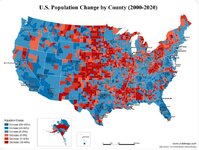@goathunter the points are that:
1) National trend in both population and hunting participation is different from the trend in the western states in question
2) the resident trend in the west is making a big change, even at low participation rates it is causing significant growth in demand by residents
3) even though the NR trend is significantly less--flat or significantly down depending on the period you look at--there are still a massively larger number of those people, so I dont see the NR demand decreasing.
The takeawy is that the national trend does have implications in the west, even if the decreases arent seen there (they arent for the most part).
Here's a map showing population change 2000-2020 which helps to make these points--note the entire intermountain west is a growth area.
View attachment 827954
And, here's an article perhaps driving home the difference between the national participation trends in hunting, versus those in "the west":
https://www.everycrsreport.com/reports/R45667.html
If you scroll down about halfway you'll see table A2, which is the number of hunting licenses sold per state each year from 2015 thru 2019--these are the numbers used to allocate pittman robertson funding to the states. This is easy to copy paste into excel if anyone wants to push and pull the data around.
Looking at the "western states" as I defined them (Ca, Co, Or, Id, Mt, Ut, Az, Wa, Wy, Ak, Nm, Nv):
In 2015,
- All the western states combined accounted for only 15.6% of the hunting licenses sold in the US
- The top 10 states (TX, PA, MI, TN, WI, MN, NC, NY, AL and MO) are all in the east or midwest (sorry, TX), and account for almost 47% of the total licenses sold in the US.
- The bottom 10 states (NM, NJ, VT, NV, NH, MA, CT, DE, HI, RI) collectively only account for 3.4% of the total
Looking at the CHANGE during the period from 2015 thru 2019,
- the western states combined increased license sales by 12.8% (CA -1.5%, CO 6.3%, Or 27%, Id 14%, MT -1%, UT 17.7%, AZ 55%, WA -.8%, WY -1.1%, AK 16%, NM 9.8%, NV 6.4%). Unlike other areas this was a steady increase each year.
- The remainder of states combined grew by only 3.2%
- the top 10 states only grew by 0.1%
- the bottom 10 states were flat, although they did grow about 1% in the middle of the period

